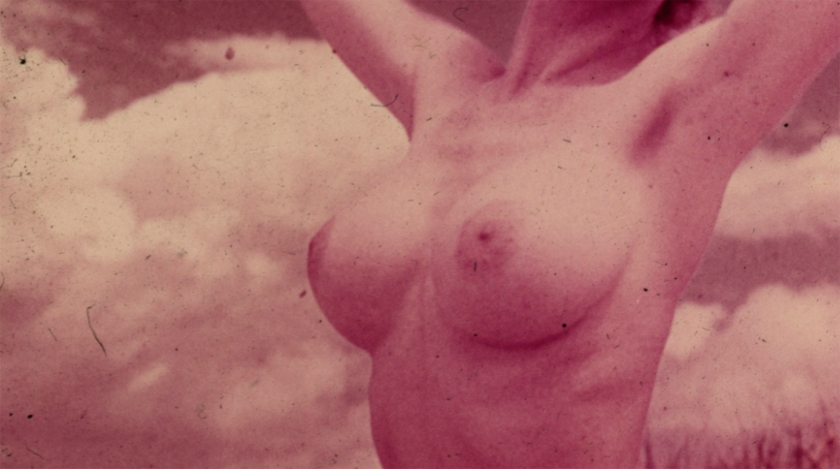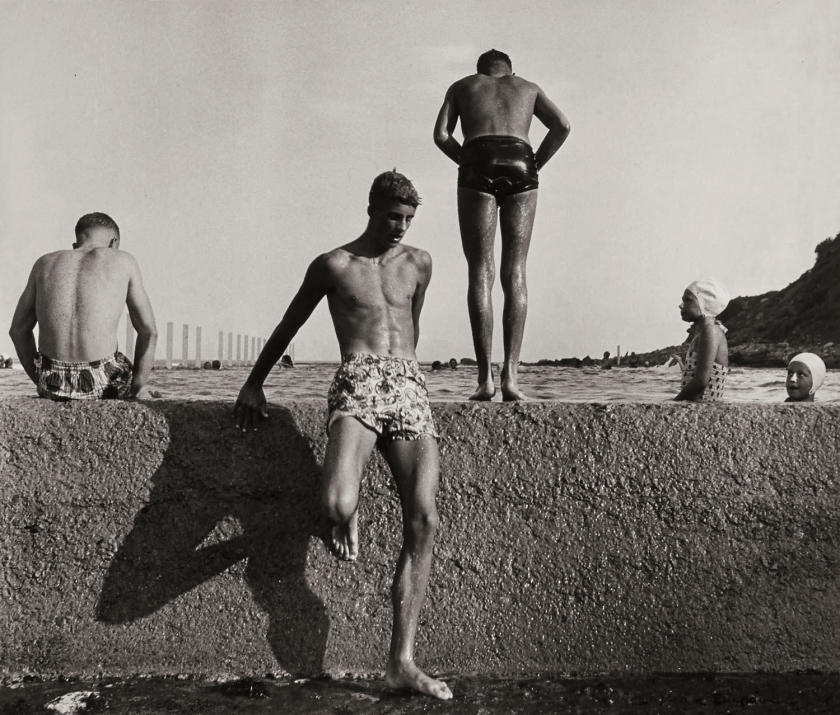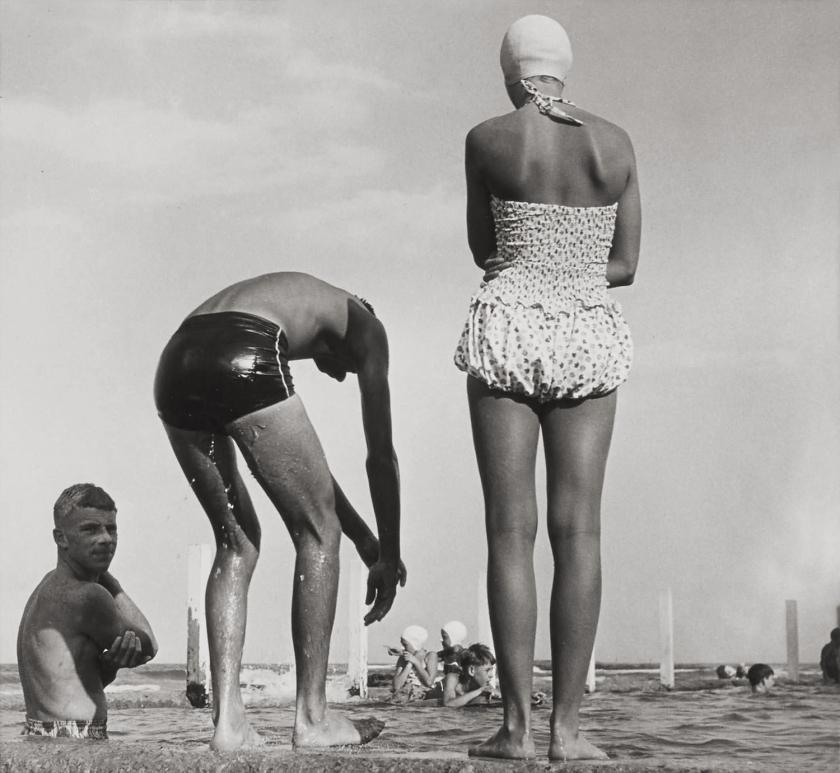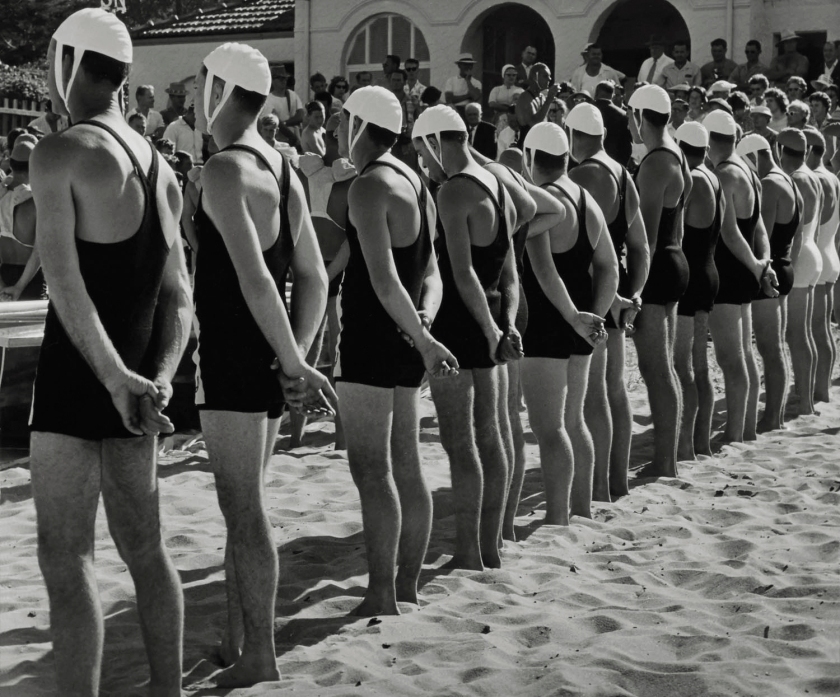January 2021
Unknown photographer (Australian?)
Nude portrait (1)
1960s?
35mm colour slide
Before lockdown struck Melbourne I travelled up to Daylesford (an hour and a half from the city) and purchased a Hanimex carousel containing approximately 88 colour slides of nude women, from an antique centre for $80. Mounted in Kodak Ready-mounts, the slide film itself has no markings – no number and no name, completely blank. These could therefore be dupe (duplicate) slides, where the film has no brand.
I have spent hours digitally restoring these slides for they were in a poor state. You can see a detail from an unrestored slide below. Unfortunately the colour has gone but I felt the slides were so interesting, so beautiful, that they were worth preserving. What makes them rare is that most of the slides are Australian, set on the beach and in the bush. I have never seen anything like them in Australian photography before. This posting features the most Australian of the slides with background of surf, sand and sea, Australian gums and fauna.
There is nothing prudish or smutty about these photographs. Despite the professional? amateur? photographer being almost certainly male (and all the appellations that the male gaze brings with it), the women are joyful when displaying their bodies, unafraid and uninhibited in the posing of their bodies before the camera. Here “the enshrining of Woman as a blank screen upon which the ideas and desires of both artist and viewer are projected” is balanced by the identity, presence and vitality of the women themselves. They take possession of their image, not simply as passive participants in the act of representation, but as active, engaged, powerful human beings who have a vital role in their own portrayal.
This posing has historical links to the history and photography of naturism (naturism is a lifestyle of non-sexual nudity, and the cultural movement which advocates for and defends that lifestyle. Both may also be referred to as nudism) and vitalist1, movements which sprung up around the world before and after the First World War.2 Examples of magazines and pamphlets from 1921-1949 can be seen at the bottom of the posting including an Australian publication, Physique Culture Art Album, c. 1936-1940. As with early male physique magazines, early naturist magazines link the beauty of the physical form to the classical ideal; and being natural, in the sun, outdoors to health and vitality (“A Magazine for all interested in Physical Fitness, Hygiene, Diet, Sunbathing, and a Healthy Natural Life”).
Whether these photographs were for personal use, or for publication, remains unknown. Either way, the photographer has access to numerous models. In this posting there seem to be 6 separate photo sessions featuring different models – 1-9, 10-14, 15-19, 20-22, 23-32, and 33-37. Numbers 1-9 and 10-14 may be the same model but I am unsure of this.
What I am sure of is this: the photographer is not some drongo who does not know how to use a camera. He is wonderfully proficient with a camera, an artist in every sense of the word. I just look at the line of the body in No. 4 and 5 and note the light, the placement of the figure against the background and the position of the horizon line, the elongation of the female form, the sensuous curve of the body… similarly, the beauty, suppleness, lighting and placement of the body in No’s 23-27 is a delight. How he fills the pictorial frame with the horizontal body in No. 25 with the knee touching the edge of the frame on the right hand side, the feet and hands touching the sand, the head thrown back and cropped, the upper line of the body following the line of the dam behind, the undulating curve of the upper and lower body mimicking the curve of the hand, low depth of field and beautiful light, is superlative.
I have never had the opportunity to photograph the female form but in finding these colour slides, rescuing them from oblivion, studying them, imbibing them, the process has given me a greater insight into the vitality and beauty of the female form, a deeper understanding of the anima (originally used to describe ideas such as breath, soul, spirit or vital force, Jung began using the term in the early 1920s to describe the inner feminine side of men),3 and of mother / earth.
Dr Marcus Bunyan
Please click on the photographs for a larger version of the image. View Part 2 of the posting.
Addendum November 2021
On 30 October 2021 I received a wonderful email from Miss Ulrike Muehlbachler in Austria. She gave me some valuable information with regard to these colour slides as below:
“All of them should be digitalised at the highest possible resolution as soon as possible. 1960’s colour slides now tend to chemical reactions – which destroys the images more and more through the years (this has been done!)
1/ The blond model is Annette Johnson. For more information on Annette Johnson please see The Kamera Club website.
2/ The voluptuous woman is UK-model Ann Austin. For more information on Ann Austin please see The Kamera Club website.
Best regards from old Austria, Europe
Miss Ulrike Muehlbachler – painting artist, music producer & former stock photographer”
More valuable information came from Russ who runs The Kamera Club website:
“The slides seem to be a mixture of models from different countries including the UK, as I can name a few. Also I’d say that although several of the models posed for Harrison Marks none of the shots are taken by him. They were originally published as sets under ‘Esquire Color Slides’ and were notorious for going red!
They were not taken at Ewhurst Manor [a legendary UK-filming location at 37 Furzehill Road, Borehamwood used for “glamour” photography, now sadly totally demolished], at least those I’ve seen taken in the gardens. I know the grounds of Ewhurst fairly well having studied numerous images of the place over the years. I can safely say there wasn’t a walled round pond there 🙂
I will need to look through the slides again, but I can see Sue Owen, Models named Robyn and Georgina and a few others I recognise.
These slides seem to turn up all over the place, so the distribution must have been pretty good even back in the 1960’s.
Russ”
Footnotes
1/ “Faced with ‘a queasy sickening feeling that all was not right’, by the fin-de-siècle many Modernists in America, Australia, Britain, Canada and Europe expanded the field of art into raw nature, ethnic communities and tribal cultures as vitalisers of energy that could be emotionally and creatively liberating. Following theories of Vitalism by Henri Bergson, Hans Driesch, Alois Riegl and Friedrich Nietzsche, ‘the vital state’ (‘l’élan vital’) became widely engaged for its conception of life as a constant process of metamorphosis, impelled by the free flow of energies able to generate what Bergson called ‘creative evolution’. Imbricated within Neo-Lamarckian ecological evolutionary theories, Vitalism was also embraced for being anti-rationalist and anti-mechanistic, particularly in its opposition to Thomas Huxley’s conception of plants and animals as machines, and its reconception of them as inspiring organisms within unspoiled nature, perpetually mutating into increasingly complex species and solidarist colonies following the Transformist concept of ‘life-force’.
Pitched against mechanistic productivity and repressive materialism, Vitalism spawned an expanding field of Modernist art in which artists embraced nature, intuition, instinct, spontaneity, chance, intense emotion, memory, unconscious states, uncanny vibrations, and a psychology of time. This pursuit was enhanced by the further expansion of art into Anthroposophy, Organicism, Supernaturalism, Magnetism, Eurhythmics, Freikorperkultur, Heliotherapy, Herbalism, Homeopathy, Naturopathy, Nudism, Theosophy and Vegetarianism, free dance plus regenerative new sports and physical cultures. The artists exploring this expanded field were doing so … within cultures as geopolitically widespread as Britain, China, France, Iceland, Oslo, Switzerland and the Soviet Union.”
Anonymous. “Vitalist Modernism,” on the Association for Art History website [Online] Cited 27/01/2021.
2/ Body culture
The terrible physical losses and psychological traumas of the First World War changed Australian society and prompted anxious concerns about the direction of the nation. For some this meant an inward-looking isolationism, a desire that Australian culture should develop independently and untouched by the ‘degenerate’ influences of Europe.
The search for rejuvenation frequently involved explorations of the capabilities and vulnerabilities of the human body. In the hands of artists, corporeal forms came to symbolise nationhood, most often expressed through references to the art of Classical Greece and mythological subjects. The evolution of a new Australian ‘type’ was also proposed in the 1930s – a white Australian drawn from British stock, but with an athletic and streamlined shape honed by time spent swimming and surfing on local beaches.
This art often has a distinctive quality to it, which in the light of history can sometimes make for disquieting viewing. With the terrible knowledge of how the Nazi Party in Germany subsequently used eugenics in its systematic slaughter of those with so-called ‘bad blood’, the Australian enthusiasm for ‘body culture’ can now seem problematic. Images of muscular nationalism soon lost their cache in Australia following the Second World War, tainted by undesirable fascistic overtones.
In the 1930s Max Dupain responded to Henri Bergson’s book Creative Evolution (1907) in which he considered creativity and intuition as central to the renewed development of society, and the artist as prime possessor of these powers. Vitalism, as this philosophy was termed, was believed to be expressed through polarised sexual energies. …
The invocation of the Classical body as a modern prototype was a powerful idea in the 1930s. The Graeco- Roman goddess Diana, the virgin patron goddess of the hunt, was popularly invoked as an ideal of female perfection, and represented with a slender and athletic physique.
Anonymous wall text from the exhibition Brave New World: Australia 1930s at the Ian Potter Centre: NGV Australia, Melbourne, July – October 2017
3/ Anima originated from Latin, and was originally used to describe ideas such as breath, soul, spirit or vital force. Jung began using the term in the early 1920s to describe the inner feminine side of men.
Anima: The inner self of an individual; the soul. In Jungian psychology, the unconscious or true inner self of an individual, as opposed to the persona, or outer aspect of the personality. In Jungian psychology, the feminine inner personality as present in the unconscious of the male.
Unknown photographer (Australian?)
Nude portrait (2)
1960s?
35mm colour slide
Unknown photographer (Australian?)
Nude portrait (2) (detail unrestored)
1960s?
35mm colour slide
Unknown photographer (Australian?)
Nude portrait (3)
1960s?
35mm colour slide
Unknown photographer (Australian?)
Nude portrait (4)
1960s?
35mm colour slide
Unknown photographer (Australian?)
Nude portrait (5)
1960s?
35mm colour slide
Unknown photographer (Australian?)
Nude portrait (6)
1960s?
35mm colour slide
Unknown photographer (Australian?)
Nude portrait (7)
1960s?
35mm colour slide
Unknown photographer (Australian?)
Nude portrait (8)
1960s?
35mm colour slide
Unknown photographer (Australian?)
Nude portrait (9)
1960s?
35mm colour slide
Unknown photographer (Australian?)
Nude portrait (10)
1960s?
35mm colour slide
Unknown photographer (Australian?)
Nude portrait (11)
1960s?
35mm colour slide
Unknown photographer (Australian?)
Nude portrait (12)
1960s?
35mm colour slide
Unknown photographer (Australian?)
Nude portrait (13)
1960s?
35mm colour slide
Unknown photographer (Australian?)
Nude portrait (14)
1960s?
35mm colour slide
Unknown photographer (Australian?)
Nude portrait (15)
1960s?
35mm colour slide
Unknown photographer (Australian?)
Nude portrait (16)
1960s?
35mm colour slide
Unknown photographer (Australian?)
Nude portrait (17)
1960s?
35mm colour slide
Unknown photographer (Australian?)
Nude portrait (18)
1960s?
35mm colour slide
Unknown photographer (Australian?)
Nude portrait (19)
1960s?
35mm colour slide
Unknown photographer (Australian?)
Nude portrait (20)
1960s?
35mm colour slide
Unknown photographer (Australian?)
Nude portrait (21)
1960s?
35mm colour slide
Unknown photographer (Australian?)
Nude portrait (22)
1960s?
35mm colour slide
Unknown photographer (Australian?)
Nude portrait (23)
1960s?
35mm colour slide
Unknown photographer (Australian?)
Nude portrait (24)
1960s?
35mm colour slide
Unknown photographer (Australian?)
Nude portrait (25)
1960s?
35mm colour slide
Unknown photographer (Australian?)
Nude portrait (26)
1960s?
35mm colour slide
Unknown photographer (Australian?)
Nude portrait (27)
1960s?
35mm colour slide
Unknown photographer (Australian?)
Nude portrait (28)
1960s?
35mm colour slide
Unknown photographer (Australian?)
Nude portrait (29)
1960s?
35mm colour slide
Unknown photographer (Australian?)
Nude portrait (30)
1960s?
35mm colour slide
Unknown photographer (Australian?)
Nude portrait (31)
1960s?
35mm colour slide
Unknown photographer (Australian?)
Nude portrait (32)
1960s?
35mm colour slide
Unknown photographer (Australian?)
Nude portrait (33)
1960s?
35mm colour slide
Unknown photographer (Australian?)
Nude portrait (34)
1960s?
35mm colour slide
Unknown photographer (Australian?)
Nude portrait (35)
1960s?
35mm colour slide
Unknown photographer (Australian?)
Nude portrait (36)
1960s?
35mm colour slide
Unknown photographer (Australian?)
Nude portrait (36) (detail unrestored)
1960s?
35mm colour slide
Unknown photographer (Australian?)
Nude portrait (37)
1960s?
35mm colour slide
Athletic Publications Ltd. (London) (Publisher)
Through the Day. How workers can easily increase their health, efficiency, and happiness
1921
Vivre Integralement #103
15th October 1931
French Naturist Magazine
Health & Physical Culture Publishing Co. Ltd. (Sydney Australia) (Publisher)
Physique Culture Art Album
c. 1936-1940
Sun Bathing Review
Vol. 7, No. 26
Summer 1939
Health & Efficiency
Volume XI, No. 4
April 1941
Health & Efficiency
Volume XI, No. 4
April 1941
The Naturist
May 1943
The Naturist
Vol. VI, No. 6
May 1943
Sun Bathing Review
Vol. II, No. 43
Autumn 1943
Rosemary Andrée
My Life Story
1945
British performer, actress, dancer and physical culture expert Rosemary Andrée. Andrée became known as Britain’s “Pocket Venus” and toured internationally in stage shows, modelled for Britain’s finest photographers, made home exercise movies for women and enjoyed great public appeal during the 1930’s and 1940’s.
Douglas Stewart
Beauty and Naturism
Paperback
April 1947
Health and Efficiency
May 1949
Unknown photographer (Australian?)
Nude portrait (38)
1960s?
35mm colour slide


































































































You must be logged in to post a comment.